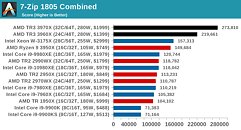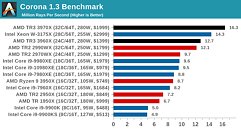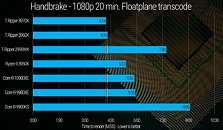Monday, November 25th 2019
HEDT Monday: AMD and Intel Launch Analysis, Results & Controversy
The HEDT or high-end desktop platform occupies the gray area between desktops and workstations. It has been originally meant for power-users, enthusiasts, and creative professionals. Over the years, with ballooning core-counts, memory bandwidth, and I/O connectivity, the target-audience of the HEDT evolved. Now these processors are useful for people who need a lot of multi-threaded CPU performance with more I/O connectivity than what traditional desktop platforms offer; and who have not use for "workstation" features such as ECC memory, or simply don't want to spend the money.
AMD doubled CPU core counts for its traditional Ryzen desktop platform this year with the introduction of 12-core and 16-core parts; forcing its 3rd gen Threadripper family to begin with even higher core-counts, starting with the 3960X 24-core part at $1,399. Intel, on the other hand, is in a bit of a pickle. Intel's 10 nm silicon fabrication node development isn't benefiting its desktop or HEDT platforms. Allocations of its 10 nm node are mopped up by its high-volume mobile processor and high-margin enterprise processor businesses, leaving too little allocation to roll out desktop or HEDT 10 nm chips at scale.Intel's 10 nm quandary has forced yet another 14 nm microarchitecture to take shape in the form of "Cascade Lake-X," with an otherwise identical IPC to "Skylake-X," but with the addition of an AI-relevant instruction-set called DLBoost. The limitation in silicon fabrication also means Intel is unable to increase core-counts. The 10th generation Core XE "Cascade Lake-X" family hence caps out at 18-core/36-thread for the top Core i9-10980XE part. Intel did not bother with a new platform, and retained compatibility with existing X299 motherboards (BIOS update required). Anticipating a slaughter from AMD "Zen 2" Threadrippers with higher core counts and competitive IPC, Intel halved prices compared to the previous generation, while axing multiple SKUs at several price-points.
For starters, Intel's 10th gen Core XE has the 10-core/20-thread i9-10900XE at $590, the 12-core/24-thread i9-10920XE at $689, the 14-thread/28-thread i9-10940XE at $784, no 16-core SKU at all, and the range-topping i9-10980XE with 18 cores and 36 threads, at $979 (prices are 1,000-unit tray, retail prices may be higher). Intel has completely conceded the four-figure HEDT market. AMD has done the opposite. In July the company launched its 12-core/24-thread traditional desktop Ryzen 9 3900X at $499, and just a few days ago 16-core/32-thread Ryzen 9 3950X followed, at $749. Just like Intel, AMD did not launch a 3rd generation Threadripper above $1000 today. The company is instead clearing off 2nd generation Threadripper inventory at various sub-$1000 price-points to compete with "Cascade Lake-X" AMD's new Threadripper lineup has just two products, the Threadripper 3960X, which is a 24-core/48-thread part priced at $1,399, and the Threadripper 3970X, a 32-core/64-thread part at $1,999.
The review embargoes on AMD's and Intel's processors were originally scheduled to lift simultaneously, but Intel did something that angered multiple reviewers. The company pulled its review embargo forward by 6 hours, hoping that reviews that come out at the earlier NDA time can't include data on AMD 3rd gen Threadripper performance, which is embargo'd until later. These reviews could then influence HEDT purchase decisions without giving people exposure on AMD's parts. Prominent YouTube-based journalist Linus Sebastian of LinusTechTips, who keeps a cooler head than his sub-zero hardware on camera, made unprecedented comments highlighting Intel's decision to "chicken out" of direct comparisons with competing AMD hardware. In an innovative move, Sebastian blurred out performance graphs of possible AMD chips without changing their positions in graphs sorted "higher is better" or "lower is better," to suggest that something faster than Intel's chips exists. Technically that is "revealing performance data", but it seems unlikely that AMD will complain. Another prominent publication, AnandTech, refused to post its Intel review before the embargo on its AMD review lifts; just so it could include AMD data in its Intel review (and vice versa).
From the 10th gen Intel Core XE reviews we've read/watched, there is a consensus that with nearly identical IPC to "Skylake-X," and the same 14 nm process as the previous generation, Intel cannot possibly compete with 3rd generation Ryzen Threadripper, and that the Core i9-10980XE will not be the fastest HEDT processor you can buy, by a long shot. In nearly all tests, the i9-10980XE offers similar performance levels to the previous-generation i9-9980XE, which it shares nominal clock-speeds with. DLBoost, which accelerates AI applications, is mentioned in most reviews, but none delved too deep into practical applications of the instruction-set, let alone comparative performance benchmarks.The Core i9-10980XE bests the 32-core 2nd gen Ryzen 2990WX in nearly all memory bandwidth-intensive benchmarks, with the latter clawing back in rendering tests that don't involve too much streaming data. The mainstream desktop Ryzen 9 3950X is a revelation here. Its high clock-speeds, with a maximum boost frequency of 4.70 GHz, higher nominal frequency, and better all-core boost frequency, lets it overcome its deficit of two cores and half the memory bandwidth, beating the i9-10980XE in numerous tests that scale with cores. It also provides superior performance in less parallelized workloads on account of its better boost state management compared to HEDT chips, all while costing $250 less, with a far cheaper platform. The Core i9-9900K with its high clock speeds still leads gaming and productivity tests such as Photoshop, which runs few threads that favor high clock-speeds.AMD's 3rd generation Ryzen Threadripper processors are a league apart from Intel's Core HEDT lineup, including the chips launched today. They are closer in performance to Intel's Xeon W-3175X, which is armed with 28 cores, a 6-channel memory interface, and a pricier platform overall, not to mention the chip's $2,999 price. Riding on not just IPC gains and increased clocks, but also substantial gains in memory bandwidth, AMD's 3rd gen Threadrippers race ahead of the competition. With memory controller being moved onto a centralized I/O controller die, 3rd generation Threadrippers now have a monolithic quad-channel memory interface (its predecessors made do with dual-channel memory interfaces of individual "Zeppelin" dies). AMD also updated the platform with a fat PCI-Express 4.0 x8 chipset bus, which has four times the bandwidth of the X399 platform.With these changes, the 24-core 3960X ends up with beating the 28-core W-3175X in encoding tests despite fewer cores, on account of better clock speeds and platform I/O. The 3960X and W-3175X trade blows in several tests from AnandTech's findings, including Handbrake, 7-zip, and y-Cruncher nT. The 32-core 3970X establishes an unassailable performance lead over the W-3175X in most HEDT-relevant tests that are not just bandwidth-intensive, but also scale with cores. The Threadrippers are also able to deliver good levels of performance in less-parallelized or gaming tasks, although are beaten by lean mainstream desktop parts such as the i9-9900K or 3950X, which dial up their clock-speeds higher.AnandTech's power testing shows that full system power consumption of the Core i9-10980XE is roughly identical to that of the i9-9980XE. The 3970X and 3960X, while drawing slightly higher power than the 2990WX and 2970WX, offer significantly higher performance-per-Watt. The Xeon W-3175X ends up the most power-hungry platform in the comparison, with worse performance-per-Watt than the 3rd gen Threadrippers. Overall, the power-draw rests at around 6-13 Watts per core. Linus Sebastian observes that it takes a reasonably powerful aftermarket cooling solution to tame the 3rd generation Threadripper processors, although any serious overclocking shouldn't be attempted without substantial cooling (we read that as a call for DIY liquid, dry ice, phase-change, or even LN2). The Core i9-10980XE offers nearly identical overclocking headroom as the i9-9980XE, and Steve Burke of GamersNexus comments that the i9-7980XE has the added convenience of de-lidding thanks to its non-soldered IHS.
Overall, the HEDT market has been enriched with today's product launches. Under the $1,000-mark, you are spoiled for choice with not just Intel's 10th gen Core XE chips, but also price-cut 2nd gen Threadrippers, and AMD's new Ryzen 9 processors that clearly offer performance in the league of Intel's HEDT chips. For those who want Avant grade HEDT performance, there's no option beyond the $1,400 3960X or the $2,000 3970X. The W-3175X has been rendered obsolete.
The complete AnandTech review that includes data for Intel and AMD processors can be read here.
AMD doubled CPU core counts for its traditional Ryzen desktop platform this year with the introduction of 12-core and 16-core parts; forcing its 3rd gen Threadripper family to begin with even higher core-counts, starting with the 3960X 24-core part at $1,399. Intel, on the other hand, is in a bit of a pickle. Intel's 10 nm silicon fabrication node development isn't benefiting its desktop or HEDT platforms. Allocations of its 10 nm node are mopped up by its high-volume mobile processor and high-margin enterprise processor businesses, leaving too little allocation to roll out desktop or HEDT 10 nm chips at scale.Intel's 10 nm quandary has forced yet another 14 nm microarchitecture to take shape in the form of "Cascade Lake-X," with an otherwise identical IPC to "Skylake-X," but with the addition of an AI-relevant instruction-set called DLBoost. The limitation in silicon fabrication also means Intel is unable to increase core-counts. The 10th generation Core XE "Cascade Lake-X" family hence caps out at 18-core/36-thread for the top Core i9-10980XE part. Intel did not bother with a new platform, and retained compatibility with existing X299 motherboards (BIOS update required). Anticipating a slaughter from AMD "Zen 2" Threadrippers with higher core counts and competitive IPC, Intel halved prices compared to the previous generation, while axing multiple SKUs at several price-points.
For starters, Intel's 10th gen Core XE has the 10-core/20-thread i9-10900XE at $590, the 12-core/24-thread i9-10920XE at $689, the 14-thread/28-thread i9-10940XE at $784, no 16-core SKU at all, and the range-topping i9-10980XE with 18 cores and 36 threads, at $979 (prices are 1,000-unit tray, retail prices may be higher). Intel has completely conceded the four-figure HEDT market. AMD has done the opposite. In July the company launched its 12-core/24-thread traditional desktop Ryzen 9 3900X at $499, and just a few days ago 16-core/32-thread Ryzen 9 3950X followed, at $749. Just like Intel, AMD did not launch a 3rd generation Threadripper above $1000 today. The company is instead clearing off 2nd generation Threadripper inventory at various sub-$1000 price-points to compete with "Cascade Lake-X" AMD's new Threadripper lineup has just two products, the Threadripper 3960X, which is a 24-core/48-thread part priced at $1,399, and the Threadripper 3970X, a 32-core/64-thread part at $1,999.
The review embargoes on AMD's and Intel's processors were originally scheduled to lift simultaneously, but Intel did something that angered multiple reviewers. The company pulled its review embargo forward by 6 hours, hoping that reviews that come out at the earlier NDA time can't include data on AMD 3rd gen Threadripper performance, which is embargo'd until later. These reviews could then influence HEDT purchase decisions without giving people exposure on AMD's parts. Prominent YouTube-based journalist Linus Sebastian of LinusTechTips, who keeps a cooler head than his sub-zero hardware on camera, made unprecedented comments highlighting Intel's decision to "chicken out" of direct comparisons with competing AMD hardware. In an innovative move, Sebastian blurred out performance graphs of possible AMD chips without changing their positions in graphs sorted "higher is better" or "lower is better," to suggest that something faster than Intel's chips exists. Technically that is "revealing performance data", but it seems unlikely that AMD will complain. Another prominent publication, AnandTech, refused to post its Intel review before the embargo on its AMD review lifts; just so it could include AMD data in its Intel review (and vice versa).
From the 10th gen Intel Core XE reviews we've read/watched, there is a consensus that with nearly identical IPC to "Skylake-X," and the same 14 nm process as the previous generation, Intel cannot possibly compete with 3rd generation Ryzen Threadripper, and that the Core i9-10980XE will not be the fastest HEDT processor you can buy, by a long shot. In nearly all tests, the i9-10980XE offers similar performance levels to the previous-generation i9-9980XE, which it shares nominal clock-speeds with. DLBoost, which accelerates AI applications, is mentioned in most reviews, but none delved too deep into practical applications of the instruction-set, let alone comparative performance benchmarks.The Core i9-10980XE bests the 32-core 2nd gen Ryzen 2990WX in nearly all memory bandwidth-intensive benchmarks, with the latter clawing back in rendering tests that don't involve too much streaming data. The mainstream desktop Ryzen 9 3950X is a revelation here. Its high clock-speeds, with a maximum boost frequency of 4.70 GHz, higher nominal frequency, and better all-core boost frequency, lets it overcome its deficit of two cores and half the memory bandwidth, beating the i9-10980XE in numerous tests that scale with cores. It also provides superior performance in less parallelized workloads on account of its better boost state management compared to HEDT chips, all while costing $250 less, with a far cheaper platform. The Core i9-9900K with its high clock speeds still leads gaming and productivity tests such as Photoshop, which runs few threads that favor high clock-speeds.AMD's 3rd generation Ryzen Threadripper processors are a league apart from Intel's Core HEDT lineup, including the chips launched today. They are closer in performance to Intel's Xeon W-3175X, which is armed with 28 cores, a 6-channel memory interface, and a pricier platform overall, not to mention the chip's $2,999 price. Riding on not just IPC gains and increased clocks, but also substantial gains in memory bandwidth, AMD's 3rd gen Threadrippers race ahead of the competition. With memory controller being moved onto a centralized I/O controller die, 3rd generation Threadrippers now have a monolithic quad-channel memory interface (its predecessors made do with dual-channel memory interfaces of individual "Zeppelin" dies). AMD also updated the platform with a fat PCI-Express 4.0 x8 chipset bus, which has four times the bandwidth of the X399 platform.With these changes, the 24-core 3960X ends up with beating the 28-core W-3175X in encoding tests despite fewer cores, on account of better clock speeds and platform I/O. The 3960X and W-3175X trade blows in several tests from AnandTech's findings, including Handbrake, 7-zip, and y-Cruncher nT. The 32-core 3970X establishes an unassailable performance lead over the W-3175X in most HEDT-relevant tests that are not just bandwidth-intensive, but also scale with cores. The Threadrippers are also able to deliver good levels of performance in less-parallelized or gaming tasks, although are beaten by lean mainstream desktop parts such as the i9-9900K or 3950X, which dial up their clock-speeds higher.AnandTech's power testing shows that full system power consumption of the Core i9-10980XE is roughly identical to that of the i9-9980XE. The 3970X and 3960X, while drawing slightly higher power than the 2990WX and 2970WX, offer significantly higher performance-per-Watt. The Xeon W-3175X ends up the most power-hungry platform in the comparison, with worse performance-per-Watt than the 3rd gen Threadrippers. Overall, the power-draw rests at around 6-13 Watts per core. Linus Sebastian observes that it takes a reasonably powerful aftermarket cooling solution to tame the 3rd generation Threadripper processors, although any serious overclocking shouldn't be attempted without substantial cooling (we read that as a call for DIY liquid, dry ice, phase-change, or even LN2). The Core i9-10980XE offers nearly identical overclocking headroom as the i9-9980XE, and Steve Burke of GamersNexus comments that the i9-7980XE has the added convenience of de-lidding thanks to its non-soldered IHS.
Overall, the HEDT market has been enriched with today's product launches. Under the $1,000-mark, you are spoiled for choice with not just Intel's 10th gen Core XE chips, but also price-cut 2nd gen Threadrippers, and AMD's new Ryzen 9 processors that clearly offer performance in the league of Intel's HEDT chips. For those who want Avant grade HEDT performance, there's no option beyond the $1,400 3960X or the $2,000 3970X. The W-3175X has been rendered obsolete.
The complete AnandTech review that includes data for Intel and AMD processors can be read here.











15 Comments on HEDT Monday: AMD and Intel Launch Analysis, Results & Controversy
It is not full 'system' but full 'package'. Package means cores plus the i/o die. Anandtech did not measure the full system power.
Maybe you should ask the same question to AMD on social media, make some noise
But still, I'm very much looking forward to seeing TPU's reviews of the CPUs and if the reviews have taught me anything today, what an absolute gem of a time to be upgrading or considering a new PC :) All at AMD my hat is firmly off to you for the amazing work and effort you've done in all of the CPU areas.. This release as been nothing short of amazing in every way possible from where they have come from.
Also, haven't we been beating Intel over the head about their supply shortages for the last year and a half? At least, rather than the Intel problem of Intel screwing up repeatedly, in AMD's case it's because they're releasing a fantastically high performing product that people want to buy.